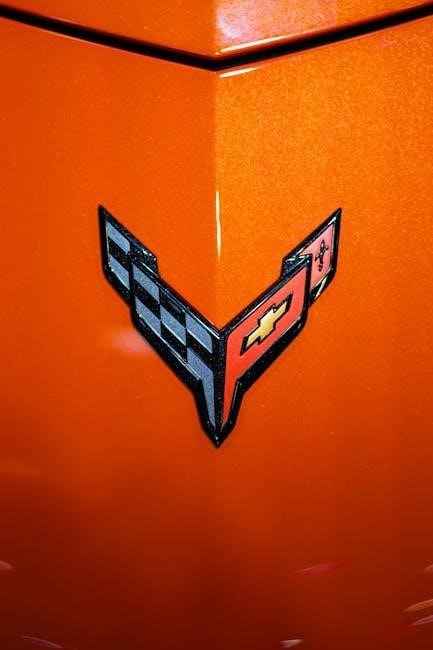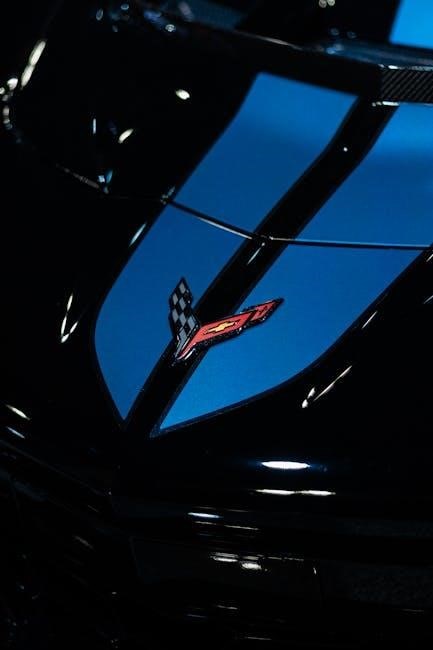The 2013 Chevy Malibu manual provides essential guidance for optimal vehicle performance, safety, and maintenance. It covers features like the eAssist system and routine care tips.
1.1 Overview of the 2013 Chevrolet Malibu
The 2013 Chevrolet Malibu is a mid-size sedan known for its balanced performance, comfort, and advanced features. It offers a range of engine options, including the fuel-efficient 2.5L Ecotec engine and the eAssist system for enhanced mileage. The Malibu features a sleek design, a spacious interior, and cutting-edge technology like Chevrolet MyLink. Safety is prioritized with features like electronic stability control and a comprehensive airbag system. This model also introduces improvements in ride quality and noise reduction, making it a versatile choice for both daily commuting and long-distance driving.
1.2 Importance of the Owner’s Manual
The owner’s manual is a comprehensive guide tailored for the 2013 Chevrolet Malibu, offering detailed insights into its features, maintenance, and operation. It provides essential information for optimizing performance, troubleshooting issues, and ensuring safety. By understanding the manual, drivers can avoid costly errors, maintain their vehicle effectively, and enhance overall driving experiences. It also covers specific systems like the eAssist technology and fuel-saving tips, making it an indispensable resource for both new and experienced owners to maximize their Malibu’s potential.

Key Features of the 2013 Chevrolet Malibu
The 2013 Chevrolet Malibu offers advanced features like the eAssist system for fuel efficiency, a 2.5L ECOTEC engine, and cutting-edge safety technologies, ensuring a superior driving experience.
2.1 Engine Options and Specifications
The 2013 Chevrolet Malibu features a 2.5L ECOTEC four-cylinder engine, delivering 197 horsepower and 191 lb-ft of torque. It also offers an optional 2.0L turbocharged engine, producing 259 horsepower and 260 lb-ft of torque. Both engines are paired with a six-speed automatic transmission, providing smooth shifting and efficient performance. The eAssist system, available on select models, enhances fuel economy by up to 14% in city driving, making it a standout choice for eco-conscious drivers.
2.2 Advanced Technology and Safety Features
The 2013 Chevrolet Malibu offers advanced technology, including Chevrolet MyLink with an 8-inch touchscreen, Bluetooth connectivity, and voice command. Safety features include electronic stability control, traction control, and a rearview camera for enhanced visibility. The available lane departure warning and forward collision alert systems add an extra layer of protection. Additionally, the Malibu features a comprehensive airbag system and robust structural design to ensure passenger safety. These technologies and features make the 2013 Malibu a reliable and modern choice for drivers.

Maintenance Schedule and Recommendations
The 2013 Chevy Malibu manual provides detailed maintenance schedules, including oil changes, tire rotations, and fluid checks, ensuring optimal performance and longevity. Refer to the manual for specific intervals and recommendations.
3.1 Routine Maintenance Services
Routine maintenance is essential for the 2013 Chevy Malibu to ensure reliability and performance. Key services include oil changes every 5,000 to 7,500 miles, tire rotations, and fluid checks. The manual recommends inspecting air filters every 15,000 miles and replacing them as needed. Brake pads and rotors should be checked annually or when symptoms arise. Regular battery testing and wiper blade replacements are also advised. Following these services helps prevent mechanical issues and maintains the vehicle’s efficiency and safety over time.
3.2 Recommended Maintenance Intervals
The 2013 Chevy Malibu manual outlines specific maintenance intervals to ensure optimal performance. Oil changes are recommended every 5,000 to 7,500 miles, while tire rotations should occur every 7,500 miles. Fluid checks and air filter inspections are advised every 15,000 miles, with replacements as needed. Brake pads and rotors should be inspected annually or when symptoms arise. Spark plugs are due for replacement at 100,000 miles, and serpentine belts at 50,000 to 105,000 miles. Adhering to these intervals ensures reliability, fuel efficiency, and longevity of your vehicle.

Owner’s Manual Guide
The 2013 Chevy Malibu manual offers a comprehensive guide to understanding and operating your vehicle. It covers essential features, troubleshooting, and maintenance tips for optimal performance.
4.1 How to Use the Manual Effectively
To use the 2013 Chevy Malibu manual effectively, start by reviewing the table of contents to locate specific sections. Pay attention to key areas like engine specifications, safety features, and troubleshooting. Utilize the index for quick access to topics. Familiarize yourself with symbols and terminology to better understand instructions. Always follow recommended maintenance schedules and refer to wiring diagrams for electrical systems. For complex repairs, consult a professional. Keep the manual handy and refer to it regularly to ensure optimal vehicle performance and longevity.
4.2 Understanding Symbols and Terminology
Understanding the symbols and terminology in the 2013 Chevy Malibu manual is crucial for effective use. Familiarize yourself with warning symbols, such as temperature or battery alerts, to identify potential issues quickly. Terms like “eAssist” refer to the hybrid system, while “RAP” stands for Retained Accessory Power. The manual uses consistent abbreviations, like “ECM” for Engine Control Module. Refer to the glossary or index for unclear terms. Accurate interpretation ensures proper maintenance and troubleshooting, enhancing safety and vehicle longevity.

Troubleshooting Common Issues
The 2013 Chevy Malibu manual helps identify and resolve common issues like error codes, warning lights, and system malfunctions. It guides resetting alerts and diagnosing problems effectively.
5.1 Identifying and Diagnosing Problems
The 2013 Chevy Malibu manual offers detailed guidance for identifying and diagnosing issues. It includes troubleshooting steps, error code interpretations, and system checks. By referencing the manual, drivers can pinpoint problems such as warning light alerts or mechanical malfunctions. The guide provides clear instructions for using diagnostic tools and understanding electrical diagrams. This helps owners address issues promptly, ensuring safety and optimal vehicle performance. Regular diagnostic checks can prevent minor problems from becoming major repairs, emphasizing the importance of proactive maintenance. The manual’s structured approach simplifies the troubleshooting process for both novice and experienced users.
5.2 Resetting Warning Lights and Error Codes
The 2013 Chevy Malibu manual provides steps to reset warning lights and error codes. Using a scan tool or the battery disconnect method can clear codes like P0xxx and P1xxx. Ensure issues are resolved before resetting to avoid recurring alerts. The manual details how to use diagnostic tools and interpret codes. Resetting without addressing the root cause may lead to repeated warnings. Always consult the manual for specific instructions to maintain your vehicle’s health and prevent false alerts. Proper resetting ensures accurate system functionality and driver safety. Regular checks are recommended for optimal performance.

Performance and Fuel Efficiency
The 2013 Chevy Malibu balances powerful performance with excellent fuel efficiency, featuring the eAssist system. Its 2.5L ECOTEC engine delivers smooth acceleration while optimizing mileage, supported by advanced technologies like automatic stop/start for enhanced economy.
6.1 Optimizing Fuel Economy
Maximizing fuel efficiency in the 2013 Chevy Malibu involves understanding its advanced systems. The eAssist technology combines a high-voltage battery with a starter/generator to enhance mileage. Driving habits play a crucial role; maintaining steady speeds and avoiding aggressive acceleration improves efficiency. Regular tire pressure checks and proper wheel alignment ensure optimal performance. Additionally, reducing extra weight and using the correct fuel type contributes to better economy. The manual provides specific tips and guidelines to help owners achieve the best possible fuel efficiency for their Malibu.
6.2 Understanding the eAssist System
The 2013 Chevy Malibu features an innovative eAssist system, designed to enhance fuel efficiency. This lightweight, advanced technology combines a high-voltage lithium-ion battery with a starter/generator to capture energy during braking. The system assists the engine during acceleration, reducing fuel consumption and emissions. It operates seamlessly, requiring no driver input, and is integrated with the vehicle’s electrical architecture. The eAssist system is a key component in achieving better mileage without compromising performance. Detailed explanations and diagrams in the manual help owners understand and utilize this technology effectively for optimal efficiency.

Safety Features and Precautions
The 2013 Chevy Malibu includes advanced safety features like airbags, anti-lock brakes, and electronic stability control to enhance protection and prevent accidents.
7.1 Airbag System and Safety Belts
The 2013 Chevy Malibu is equipped with a comprehensive airbag system, including front, side, and knee airbags, designed to provide enhanced protection during collisions. Safety belts are also crucial, with features like pretensioners to ensure secure restraint. Proper use of these systems is emphasized in the manual to maximize occupant safety. Regular inspection of airbags and belts is recommended to ensure functionality. The manual outlines procedures for checking and maintaining these critical safety components.
7.2 Electronic Stability Control and Traction Control
The 2013 Chevy Malibu features advanced Electronic Stability Control (ESC) and Traction Control System (TCS) to enhance vehicle stability and traction. ESC helps prevent skidding by automatically adjusting engine power and braking. TCS reduces wheel spin during acceleration, improving grip on slippery surfaces. Both systems are standard and operate seamlessly without driver intervention. The manual advises drivers to avoid deactivating these features unless necessary, such as in deep snow conditions. Proper maintenance ensures optimal performance of these critical safety technologies.

Customization and Modifications
The 2013 Chevy Malibu manual highlights customization options to enhance performance and aesthetics. Explore engine upgrades, suspension modifications, and interior/exterior accessory installations to personalize your vehicle while adhering to Chevrolet guidelines.
8.1 Upgrading Your Malibu’s Performance
Upgrading your 2013 Chevy Malibu’s performance can enhance its power and efficiency. Consider engine modifications, such as upgrading to a cold air intake or performance exhaust system, to improve horsepower. The 2.5L LCV or 2.0L LTG engine can be optimized with aftermarket components. Additionally, upgrading the transmission with a performance-tuned 6-speed automatic can improve acceleration. Suspension modifications, like sport-tuned shocks, can enhance handling. For fuel efficiency, optimizing the eAssist system or adding a performance chip can refine power delivery. Always follow Chevrolet guidelines to ensure compatibility and reliability.
8;2 Interior and Exterior Accessories
Customizing your 2013 Chevy Malibu with interior and exterior accessories can enhance its style and functionality. Interior upgrades include premium seat covers, dash trim kits, and ambient lighting. For the exterior, consider alloy wheels, spoilers, or chrome emblems to add a personalized touch. Accessories like roof racks or cargo trays improve versatility. Ensure all modifications are compatible with your Malibu’s specifications and installed correctly to maintain performance and safety. Refer to the manual or consult Chevrolet guidelines for recommended accessory installations and configurations.
Electrical Systems and Wiring Diagrams
The 2013 Chevy Malibu’s electrical system includes detailed wiring diagrams for circuits, connectors, and components. These diagrams help diagnose and repair issues efficiently, ensuring proper functionality.
9.1 Understanding the Electrical System
The 2013 Chevy Malibu’s electrical system is designed for reliability and performance. It includes circuits for power windows, infotainment, and safety features. The system uses fuses and relays to protect against overcurrent, ensuring components function correctly. Wiring diagrams provide a clear overview of connections, making it easier to identify and repair faults. Regular inspection of wires and connectors is recommended to prevent electrical issues. Refer to the manual for specific guidance on troubleshooting and maintaining the electrical system effectively.
9.2 Accessing and Interpreting Wiring Diagrams
The 2013 Chevy Malibu manual includes detailed wiring diagrams to help diagnose and repair electrical systems. These diagrams are available in the manual or online as PDFs. They provide a visual representation of wire connections, making it easier to trace circuits and identify faults. Symbols and color codes are used to differentiate wires by function. To interpret them, refer to the legend provided in the manual. Using a multimeter and understanding these diagrams can help pinpoint electrical issues efficiently. Regularly reviewing the diagrams ensures accurate repairs and maintenance;

Repair and Replacement Guidelines
The manual provides detailed repair procedures, torque specifications, and labor times for various components. It ensures proper tool usage and adherence to manufacturer guidelines to prevent damage.
10.1 Common Repair Procedures
The 2013 Chevy Malibu manual outlines step-by-step repair procedures for common issues, ensuring proper diagnostic and fixing techniques. It covers engine mechanical repairs, electrical system troubleshooting, and replacement of key components like brakes and suspension. Detailed torque specifications and labor times are provided for accuracy. The guide emphasizes using approved tools and adhering to safety protocols to prevent further damage. By following these procedures, owners and technicians can restore the vehicle to optimal condition efficiently and reliably.
10.2 Replacing Parts and Components
Replacing parts in the 2013 Chevy Malibu requires adherence to specified torque values and the use of approved components. The manual provides detailed torque specifications for various bolts and nuts, essential for avoiding damage during repairs. It also lists recommended replacement parts that ensure compatibility and safety. Step-by-step instructions guide the replacement process, whether it’s a single part or multiple components. Special attention is given to electrical systems, with diagrams and safety precautions to prevent issues like short circuits. The manual emphasizes using proper tools, such as a torque wrench, and following safety measures like disconnecting the battery before starting electrical work. Additionally, it highlights common pitfalls to avoid and suggests documenting all repairs for future reference. By following these guidelines, owners can ensure reliable and safe replacements, maintaining their vehicle’s performance and value.
The 2013 Chevy Malibu manual is an indispensable resource for owners, ensuring optimal performance, safety, and longevity. Regular maintenance and understanding the vehicle’s systems are crucial for a seamless driving experience. By following the guidelines, owners can maximize fuel efficiency, troubleshoot issues, and customize their Malibu to meet personal preferences. Staying informed and proactive about vehicle care enhances reliability and satisfaction, making the 2013 Malibu a trusted companion on the road.
11.1 The Importance of Regular Maintenance
Regular maintenance is crucial for the 2013 Chevy Malibu to ensure optimal performance, fuel efficiency, and longevity. Routine services like oil changes, tire rotations, and brake inspections prevent potential issues. Adhering to the recommended schedule in the manual helps maintain the vehicle’s condition, reducing repair costs and enhancing safety. Proper care also preserves the resale value and ensures the car runs efficiently for years. By following the guidelines, owners can avoid unexpected breakdowns and keep their Malibu performing at its best.
11.2 Staying Informed About Your Vehicle
Staying informed about your 2013 Chevy Malibu ensures optimal performance, safety, and longevity. The owner’s manual serves as a comprehensive guide, detailing features, maintenance schedules, and troubleshooting tips. Additional resources, such as online forums and repair manuals, provide deeper insights and solutions. Regularly reviewing the manual and staying updated on the latest information helps owners make informed decisions, address issues promptly, and maintain their vehicle in peak condition. Knowledge empowers drivers to maximize their Malibu’s potential and enjoy a trouble-free driving experience.

Additional Resources and References
Explore official Chevrolet websites, authorized dealers, and online forums for parts, tools, and expert advice. Join enthusiast communities to share insights and learn about modifications and repairs.
12.1 Recommended Tools and Equipment
For maintaining and repairing your 2013 Chevy Malibu, essential tools include a multimeter, wrench set, screwdriver kit, and OBD-II scanner. Use genuine Chevrolet parts and approved diagnostic software. Refer to the repair manual for specific torque specifications and labor guidelines. Additional resources like wiring diagrams and electrical schematics are available online or through authorized dealers. Online forums and communities provide valuable insights and DIY guides, ensuring you have everything needed to keep your Malibu in optimal condition.
12.2 Online Communities and Forums
Online communities and forums dedicated to the 2013 Chevy Malibu offer valuable resources for owners; Websites like Chevy Malibu Owners Club and Malibu Forums provide DIY guides, troubleshooting tips, and discussions on modifications. These platforms allow owners to share experiences, ask questions, and access detailed repair information. Many forums include sections for wiring diagrams, maintenance schedules, and performance upgrades. They serve as a central hub for staying informed and connected with other Malibu enthusiasts, ensuring you can optimize your vehicle’s performance and address issues effectively.
